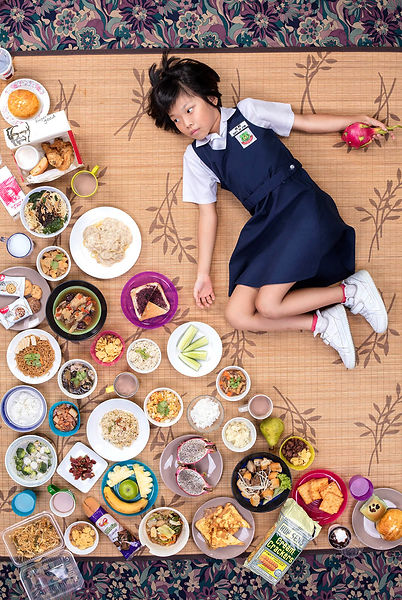Thinking About Photography
Dedicated to expanding our ideas about photography
Gregg Segal

Anchal Sahani, Chembur, Mumbai, India (10 yrs old) photographed March 11, 2017. Anchal lives in a tiny tin shack on a construction site in a suburb of Mumbai with her parents and two siblings. Her father makes less than $5 a day, just enough for her mother to prepare okra & cauliflower curry, lentils and roti from scratch. Anchal would like to return to the farm where she was born in Bihar, go to school like other kids and eventually become a teacher, but she’s kept busy with household chores and looking after her baby brother. When she has time, she dresses up and leaves the construction site to enjoy the fragrance of jasmine and lotus and to watch the neighborhood kids playing cricket and running free. While on her walks, Anchal collects brightly colored chocolate wrappers she finds along the road by the grocery store. Anchal wishes her mother would love her the way she loves her baby brother.
© Gregg Segal, Anchal Sahani, 2017
Daily Bread
In an 8 x 8 aluminum hut on a construction site on the outskirts of Mumbai, Anchal Sahni, 10, sits down to dinner with her family: homemade aloo bhindo (okra and potatoes simmered in curry) and chapati (flatbread) with a side of lentils. Anchal has a healthier diet than many middle-class kids in India, who can afford to buy their meals ready made. If your kid is eating at a Dominoes in Mumbai, you’re making decent money: a medium pizza runs 13 bucks – about 3 times what Anchal’s father earns a day!
It isn’t just in India where the middle-class is flocking to Dominoes, KFC and McDonalds. Sensing a sea change in attitude about diet and the effects of junk food, fast food companies have invested heavily in foreign markets where public awareness isn’t as keen – and Big Macs aren’t junk – they’re a status symbol.
Meissa Ndiaye, 11, Dakar, Senegal, photographed August 30, 2017. Meissa shares a single room with his dad, mum and brother in the heart of Parcelles Assainies, which means “sanitized plots.” A treeless, sandy suburb of Dakar, Parcelles Assainies was developed in the 1970’s to house the poor overflowing from the city. Meissa lives opposite the futbol stadium and open-air market, hundreds of stalls selling everything from fresh fish to wedding dresses. In late August, tethered goats line the streets before Eid al-Adha, the Feast of the Sacrifice. Meissa, a devout Muslim and student at Quran School, loves goat meat and sweet foods like porridge, though in the week he kept a diary of his meals, he ate very little meat. More often, he filled up on French bread stuffed with spaghetti, peas or fried potatoes. Meissa’s mum and anties prepare his meals though once or twice a week they get take out. Meissa loves futbol most of all and hopes to be a star player like Messi or Ronaldo. If he had enough money, he’d buy a nice little sports car. He wishes his mum and dad, a refrigerator technician, could immigrate to France so that they can earn enough money.

© Gregg Segal, Meissa Ndiaye, 2017
In 2015, Cambridge University conducted an exhaustive study, identifying countries with the healthiest diets in the world. 9 of the top 10 countries are in Africa – where whole foods (vegetables, fruit, nuts, legumes, grains) are the staple and meals are homemade. Processed, packaged foods either aren’t available or affordable.
As globalization challenged traditional regional diets, I made my way around the world, asking kids to keep a journal of everything they ate in a week. Once the week was up, I made portraits of the children with the food arranged around them. I focused on kids because eating habits, which form when we’re young, last a lifetime and often pave the way to chronic health problems like diabetes, heart disease, and colon cancer.

© Gregg Segal, Kawakanih Yawalapiti, 2018
Kawakanih Yawalapiti, 9, Upper Xingu region of Mato Grosso, Brazil, photographed August 19, 2018 in Brasilia. Kawakanih, whose last name comes from her tribe, the Yawalapiti, lives in Xingu National Park, a preserve in the Amazonian Basin of Brazil that can be seen from space. The park is encircled by cattle ranches and soybean crops. In the past six months alone, nearly 100 million trees have been destroyed by illegal logging and expanding agrobusiness. The Yawalapiti and other Xingu tribes collect seeds to preserve species unique to their ecosystem, which lies between the rain forest and savannah. The Yawalapiti’s language is threatened, too. When Kawakanih was born, only seven speakers of Arawaki remained. Determined to keep the language from going extinct, Kawakanih’s mother, Watatakalu, isolated her daughter from those who didn’t speak Arawaki. Kawakanih is the first child to be raised speaking Arawaki since the 1940’s and her mother says it’s up to her children now to keep the language alive. Kawakanih has also learned her father’s dialect as well as Portuguese. She loves to read history books, especially ones about the Egyptians. Her days are spent playing in the river, fishing, helping with chores, harvesting manioc, making beiju (cassava flatbread) and beading necklaces worn during tribal rituals. Every couple months, Kawakanih travels to Canarana for school where she learns computer skills, though no one in her village owns a computer; there is no electricity or running water. To get to the studio in Brasilia, Kawakanih and her mother traveled 31 hours from their village by boat, bus and car. Kawakanih’s body paint protects her from bad spirits and energy. Black paint is made from jenipapo fruit and red is made from ground urucum seeds (a pod of seeds lies to the left of her head). Rainforest tribes have used the entire Urucum plant as medicine for centuries. Kawakanih’s diet is very simple, consisting mainly of fish, cassava, porridge, fruit and nuts. “It takes five minutes to catch dinner,” says Kawakanih. “When you’re hungry, you just go to the river with your net.”
Beryl Oh Jynn, 8, Kuala Lumpur, Malaysia, photographed March 25, 2017. Beryl lives in a quiet condominium with her parents and two brothers. She goes to S. J. K. Han Ming Puchong, a national Chinese school walking distance from home. Beryl’s dad is an engineer and her mother runs a day care. Beryl’s earliest memory of food is porridge and cake. Her favorite dish is spaghetti with carbonara sauce. Beryl grows bok choy and spinach in her balcony garden, is not permitted to drink sodas and refuses to eat ginger. She would like to be a cheerleader.

© Gregg Segal, Beryl Oh Jynn, 2017

© Gregg Segal, Davi Ribeiro de Jesus, 2018
Davi Ribeiro de Jesus, 12, Brasilia, Brazil, photographed August 18, 2018 . Davi lives with his dad, step-mom and three siblings in a tidy one-room house in the Santa Luzia favela, a slum at the edge of the largest garbage dump in Latin America. The space is filled by three beds, a sofa, TV, refrigerator, two wardrobes, a cooker and a small table where they share their meals. A mosaic of mats and scraps of plywood cover the dirt floor. Davi has his own shelf where he arranges his clothes, his toy car collection, and his mobile. There’s no garbage collection and the power goes down frequently. When it rains, scattered garbage turns to sludge and oozes into homes, but Jesus keeps Davi and his family safe and happy. They go to a church nearby every Saturday night and Sunday morning. Davi’s dad is looking for work as a digger. He has his own pick, shovel and grubber. Davi’s step-mom handles the cooking. Davi will eat almost anything except bitter legumes though most days he has beans and rice, maybe with a little pork. He can cook fried eggs, porridge and pasta for himself. Sometimes there are treats, like sweet popcorn. He never goes to bed hungry. Davi laughs easily and is crazy about kites. He and his friends, Maxwell, Junior and Romário have kite fights in the favela’s empty lots where bored stray dogs scratch at fleas or sniff around for food. Davi adopted five strays and gave them names: Lassie, Beethoven, Tchutchuquinha, Belinha and Piloto. He also has a chicken and wants a horse. He wants to learn all about cars, motorcycles, helicopters and guns, too. His dad taught him to drive and now he dreams of having a Chevy. He’d like to be a cop when he grows up because it’s better to be a cop than a thief.
Altaf Rabbal DLove Bin Roni, 6, Gombak, Malaysia, photographed March 26, 2017. Altaf and his family live in Kampung Kerdas, a small village of about 30 families on the outskirts of Kuala Lumpur. There are many children Altaf’s age. They chase each other around the neighborhood almost every evening and pick fruit from the trees: mango, rambutan and mangosteen. If it’s raining, they’ll play marbles. Often, Altaf visits his grandparents who live five minutes away. Altaf’s father makes and sells satay sticks at his own stand and runs delivery for a Malaysian on-line platform part-time while his mom takes care of the house and kids; she’s expecting her 4th soon. Altaf’s favorite food is his father’s chicken and beef satay. It’s seasoned with ginger and herbs, roasted over a charcoal fire and served with sliced, cold cucumber. Altaf dips his satays in a tangy sauce made with roasted ground peanuts, chili paste, garlic and lemongrass. Altaf will eat any “tasteful” food (made with a lot of ingredients and flavors) and likes raw, leafy greens like Ulam-Ulam, a salad eaten with anchovies, cincalok (a condiment made from fermented krill) and sambal (hot sauce). The only foods Altaf avoids are pickles and other sour things. Altaf collects parcel stickers, big, colorful ones, and likes to discover new things. He loves science because to him it is magic. When he grows up, he wants to be a pilot. He loves to fly like birds while watching the skies and clouds. As he falls asleep, Altaf thinks of what he’ll do tomorrow: catch fish, climb a tall fruit tree, or cycle far from his village.

© Gregg Segal, Altaf Rabbal DLove Bin Roni, 2017
Despite growing awareness here in the US about the harm of eating processed foods, awareness hasn’t yet led to widespread change. Obesity rates are still soaring. 40 years ago, 1 out of 40 kids were obese. Today, 10 in 40 are. Since corn syrup came along, the incidence of diabetes has tripled. For the first time in many generations, life expectancy in America is declining and the main culprit is empty calories.
I’ve been encouraged to find regions and communities around the world where slow food will never be displaced by junk food, where home cooked meals are the bedrock of family and culture, where love and pride are sensed in the aromas of broths and stews and curries. When the hand that stirs the pot is mom or dad, grandma or grandma, kids are healthier. The deeper goal of Daily Bread is to be a catalyst for change and link to a growing, grassroots community that is moving the needle on diet.